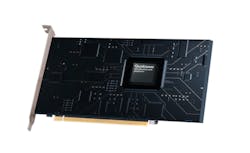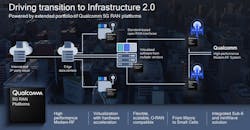Qualcomm Plugs into 5G Base Stations With PCIe Accelerator Card
Qualcomm has taken the early lead in advanced modem chips for 5G smartphones. But now the company is expanding its ambitions in the technology with a new server-grade accelerator card for 5G base stations.
The semiconductor giant recently rolled out its 5G DU X100 accelerator card that can be used in the cluster of servers in the bowels of a base station to process the radio signals traveling through the antennas at the top of the tower. The accelerator card plugs into the base station's servers—also called the distributed unit or DU—over a PCIe slot to offload beamforming and other 5G baseband chores from the macrocell's CPU.
Today, most 5G base stations have two primary components: antennas and other electronics that convert and amplify radio frequency signals in the radio unit. Then the distributed unit is used to perform some of the more time-sensitive baseband functions on data passing from the antennas. Nokia, Ericsson, Huawei Technologies, and other telecom equipment giants sell both of these components in a closed and proprietary bundle that combines in-house firmware and software running on made-to-order chips.
But the way wireless carriers are building out cellular infrastructure is changing. A new technology called "virtualized" radio access networks allows them to use cheaper, commodity gear and off-the-shelf CPUs to build 5G networks. That also allows carriers to avoid being locked into a single vendor and to assemble base stations part by part, bolstering competition in 5G gear and opening the door for new suppliers.
But these types of processors cannot handle the huge amount of data in 5G networks alone. The problem is the PHY layer in the RAN protocol stack depends on real-time baseband functions and complex signal processing algorithms that drag on the CPU in a base station’s server, sapping performance and adding latency. To boost a network's capacity, telecoms have supplemented the CPUs with accelerators, largely based on FPGAs from Xilinx and Intel that are hardware-programmed to run a range of 5G workloads.
Last year, Qualcomm said that it was trying to expand its footprint in 5G base stations with a new family of systems on a chip (SoCs) that are less programmable but more power-efficiency and cheaper than FPGAs.
The San Diego, California-based company placed one of these chips on the 5G DU X100 server accelerator card, which can support the so-called sub-6 and millimeter waves bands used by 5G networks at the same time. According to Qualcomm, the DU X100 slots into any industry-standard server via its PCIe port, giving telecom gear vendors and wireless carriers "a turnkey solution for ease of deployment" in 5G base stations.
Qualcomm said DU X100 can handle a wide range of baseband and signal-processing chores-also called Layer 1 functions-offloading them from a server's CPU. For instance, every time a smartphone sends data to a base station, it encodes the information in a radio transmission called a carrier wave. The accelerator can handle demodulation functions, decoding the radio signal and filtering out any interference in the data.
The card can also handle the heavy computations behind massive MIMO technology, which requires the use of radios with many more cellular antennas at each base station. Today, the base stations behind 5G networks tend to have 64 to 128 antennas that can focus radio frequency signals like spotlights targeted directly at smartphones and other devices instead of casting radio waves in a wide cone, like a floodlight.
These massive MIMO antennas mean that base stations can send and receive many more signals at the same time, bolstering the base station's efficiency and increasing the capacity of the carrier's 5G network.
The DU X100 can also assist with the underlying beamforming technology used to carefully coordinate the signals shooting out of the antennas packed into the 5G base station. Beamforming is used to identify the ideal transmission route to a smartphone or other device and route the radio waves around any obstacles, resulting in faster data rates at the same power. And because the base station moves signals in a specific direction instead of broadcasting them all around, there is a lot less interference on a carrier's 5G network.
Beamforming is also ideal for millimeter-wave bands, which are liable to be blocked by walls and weaken over long distances by focusing the signals into stronger beams and shaping them around obstructions.
The chip can also handle channel coding algorithms, which correct errors in radio transmissions resulting from interference or weak signals. Channel coding helps to prevent re-transmissions, reducing the latency. It can also be used for fronthaul functions that ferry information from the crown of antennas on a 5G base station to the baseband system, which in turn works to forward data packets to the carrier's core network.
Qualcomm said the DU X100 card is a so-called "inline" accelerator placed in front of the CPU in the base station and intercepts packets traveling from the antennas. As a result, Qualcomm said that it can process data packets used in beamforming and other baseband functions without any CPU intervention, reducing the latency and power use. That, consequently, lessens the power and cooling costs of a 5G base station.
According to Qualcomm, offloading the baseband functions to the X100 card reduces the number of CPU cores telecom firms are forced to buy per 5G base station. That potentially brings down hardware costs.
Qualcomm is not alone in expanding its ambitions in 5G. For instance, Nvidia is trying to carve out a larger share of the market with its Bluefield family of DPUs, which offload networking and other workloads from the CPU to wring more performance out of servers. Late last month, the company rolled out a plug-in 5G accelerator card for servers based on a Bluefield-2 DPU, Ampere A100 GPU, and "Aerial" software toolkit.
Marvell is also trying to repel Qualcomm, Xilinx, Broadcom, and other rivals in the base station market with its latest Octeon family of DPUs, which are the industry's first server processors to use TSMC's 5-nm node.
The X100 card can also support the open RAN standard for open radio access networks. Open RAN serves as a software interface between the building blocks of a 5G base station, giving telecom firms the ability to mix and match parts from different vendors. That mirrors the way most modern data centers are equipped with a wide assortment of "white box" servers and other general-purpose boxes of gear from various firms.
Open RAN promises to give telecom firms the flexibility to roll out features to 5G networks faster and more cheaply by upgrading the base station with software or hardware based on the open RAN standard. This is a potential alternative to buying proprietary sets of hardware and software sets from Huawei Technologies, Nokia, Ericsson, Samsung, and other telecom gear manufacturers that are incompatible with each other.
“We are working closely with mobile operators, network equipment vendors, standards bodies, and other key stakeholders, to enable the deployment of innovative, high-performance, virtualized, and modular 5G networks at scale," Durga Malladi, senior vice president of the 5G infrastructure business Qualcomm, said in a statement. The company hopes to supply the accelerator to existing vendors as well as new players.
Qualcomm said that it plans to start sampling the DU X100 accelerator card by the first half of 2022.
About the Author
James Morra
Senior Editor
James Morra is the senior editor for Electronic Design, covering the semiconductor industry and new technology trends, with a focus on power electronics and power management. He also reports on the business behind electrical engineering, including the electronics supply chain. He joined Electronic Design in 2015 and is based in Chicago, Illinois.



